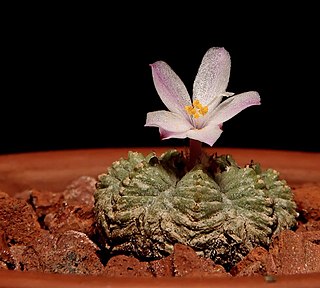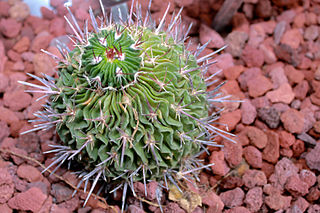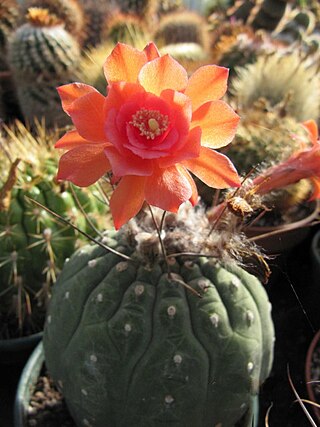
Primula is a genus of herbaceous flowering plants in the family Primulaceae. They include the primrose, a familiar wildflower of banks and verges. Other common species are P. auricula (auricula), P. veris (cowslip), and P. elatior (oxlip). These species and many others are valued for their ornamental flowers. They have been extensively cultivated and hybridised. Primula are native to the temperate Northern Hemisphere, south into tropical mountains in Ethiopia, Indonesia, and New Guinea, and in temperate southern South America. Almost half of the known species are from the Himalayas.

Ribes is a genus of about 200 known species of flowering plants, most of them native to the temperate regions of the Northern Hemisphere. The various species are known as currants or gooseberries, and some are cultivated for their edible fruit or as ornamental plants. Ribes is the only genus in the family Grossulariaceae.

Agave parryi, known as Parry's agave or mescal agave, is a flowering plant in the family Asparagaceae, subfamily Agavoideae. It is a slow-growing succulent perennial native to Arizona, New Mexico, and northern Mexico.

Bergerocactus emoryi is a species of cactus, known commonly as the golden-spined cereus, golden snake cactus, velvet cactus or golden club cactus. It is a relatively small cactus, but it can form dense thickets or colonies, with the dense yellow spines giving off a velvety appearance when backlit by the sun. From April to May, yellow, green-tinged flowers emerge, which transform into reddish, globular fruit. This species is native to the California Floristic Province, and is found in northwestern Baja California and a small part of California, in San Diego County and on the southern Channel Islands. Where the Mediterranean climate of the California Floristic Province collides with the subtropical Sonoran Desert near El Rosario, hybrids with two other species of cacti are found. It is the sole member of the monotypic genus Bergerocactus, named after German botanist Alwin Berger.

Andira inermis is a nitrogen-fixing tree with medicinal properties native to the area from southern Mexico through Central America to northern South America ; it has been introduced to the Caribbean, the Antilles, Florida, and Africa and is often pollinated by bees. The tree has many names due to its wide distribution and multiple uses: it is also known as the cabbage bark, almendro macho, almendro de río or river almond (Honduras), bastard cabbage tree, cabbage angelin, cabbage bark, cabbage tree, carne asada, guacamayo (Honduras), Jamaica cabbage tree, harino (Panama), moca, partridge wood, worm bark, or yellow cabbage tree.

Kroenleinia grusonii, popularly known as the golden barrel cactus, golden ball or mother-in-law's cushion, is a species of barrel cactus which is endemic to east-central Mexico.

Disocactus phyllanthoides, the nopalxochitl or German empress, is a species of flowering plant in the cactus family Cactaceae. It is commonly grown as an ornamental houseplant. It is one of the three major species involved in creating the widely grown epiphyllum hybrids or "epis". The others are Disocactus speciosus and Disocactus crenatus.

Jepsonia parryi is an uncommon species of flowering plant in the saxifrage family known by the common names coast jepsonia and Parry's jepsonia. It is a small geophytic plant that flowers briefly during fall, and often only has a single leaf that may appear above the ground after or during flowering. It is native to the coast and inland hills chaparral of southern California and Baja California.

Aztekium ritteri is a species of cactus native to the Mexican state of Nuevo León.

Echinocactus platyacanthus, also known as the giant barrel cactus, golden barrel cactus, giant viznaga, or biznaga de dulce, Its Nahuatl (Aztec) name is Huitzli nahual. It is a species of cactus. It is native to central Mexico in the Chihuahuan Desert. This species is the largest of the barrel cacti. In Mexico the hairs are often used for weaving; the acitrón, a traditional Mexican candy, is produced by boiling the pith.

Ferocactus fordii is a species of succulent plant in the family Cactaceae, commonly known as Ford's barrel cactus, endemic to the Baja California Peninsula of Mexico. It is spherical, growing to 50 cm (20 in) in diameter, with whitish-grey radial spines and solitary flowers of a deep rose pink, 4 cm (2 in) in diameter.
Chionanthus polycephalus is a tree in the family Oleaceae. The specific epithet polycephalus means "many-headed", referring to the inflorescence.

Stenocactus multicostatus, the brain cactus, is a member of the cactus family native to the deserts of Mexico, and is popular in the gardening community. It has gained the Royal Horticultural Society's Award of Garden Merit.

Matucana aurantiaca is a species of flowering plant in the cactus family Cactaceae. It grows in the Cajamarca and La Libertad regions of Peru. It is considered to have a stable population and a wide range with no threats.

Gnaphalium polycaulon, the many stem cudweed, is a plant species in the family Asteraceae. It is widespread across much of Mesoamerica, South America, and the West Indies, and naturalized in parts of Asia and Africa.

Parodia herteri is a species of cactus in the subfamily Cactoideae. It is endemic to Brazil. It was named for botanist Wilhelm Herter. The first description was in 1936 as Echinocactus herteri by Erich Werdermann. It was described as Parodia herteri in 1987 by Nigel Paul Taylor.

Echinocactus texensis is a cactus in the subfamily Cactoideae. It is endemic to the United States and Mexico. It has one synonym.

Gymnocalycium baldianum, the spider-cactus or dwarf chin cactus, is a species of flowering plant in the cactus family Cactaceae, native to the Catamarca Province in Argentina.

Ferocactus diguetii, commonly known as the giant barrel cactus, is the largest species of barrel cactus in the genus Ferocactus. It is an insular species endemic to several of Baja California Sur's southern islands in the Gulf of California. As the superlative giant of the barrel cacti, it reaches heights of up to 4 metres (13 ft) and diameters of 1 metre (3.3 ft) in the wild, a result of island gigantism. The species has red flowers that bloom from March to May. Although restricted in range, this species grows in protected habitat and lacks major threats.

Acharagma roseanum is a succulent cactus native to a small area of mountains of southeastern Coahuila and Nuevo León, Mexico. It grows on rocky limestone hills and xerophytic shrubland. Its name is often misspelled as "Roseana".




















